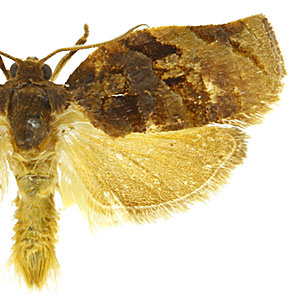Adult Recognition

FWL: 9.0-13.0 mm
Forewings are a mix of purplish brown and yellowish brown, with a dark reddish-brown median fascia and costal spot. Hindwings and abdomen are orange. Males are more heavily marked than females and dark forms exist where the hindwings and abdomen are grayish brown. Females are larger than males, and the costal margin of the female forewing is sinuate. Males have a short forewing costal fold.
Male genitalia are characterized by a broad uncus, large gnathos, and membranous valvae. Female genitalia are characterized by a twisted ductus bursae and single signum in the corpus bursae.
Choristoneura heliaspis (= Cacoecia heliaspis) was synonymized under Archips occidentalis by Brown (2005). Razowski (2008) resurrected the name based on minor differences in the male sacculus and placed it in the genus Choristoneura.
Biology

Females lay eggs in masses on the upper surface of leaves and cover them with a white protective secretion. On citrus, larvae prefer to feed on young fruit under the calyx, causing damage similar to that of citrus thrips. Larvae will also feed on leaves, young growth, and web leaves to fruit. Pupation occurs in rolled or webbed leaves. In South Africa, most damage to oranges is caused from October to November.
Host plants
In South Africa, C. occidentalis is a pest of citrus, avocado, coffee, and various ornamentals. Larvae of the apple leafroller (Lozotaenia capensana) cause similar damage to crops such as avocado.
| Family | Genus/species | Common name |
| Fabaceae | Acacia mearnsii De Wild. | black wattle |
| Fabaceae | Cajanus Adans. | cajanus |
| Fabaceae | Glycine max (L.) Merr. | soybean |
| Fabaceae | Vigna unguiculata (L.) Walp. | blackeyed pea |
| Liliaceae | Allium L. | onion |
| Malvaceae | Gossypium L. | cotton |
| Ochnaceae | Ochna thomasiana Engl. & Gilg | Thomas' bird's-eye bush |
| Pinaceae | Pinus patula Schiede ex Schltdl. & Cham. | Mexican weeping pine |
| Rosaceae | Rosa L. | rose |
| Rubiaceae | Coffea L. | coffee |
| Rubiaceae | Coffea arabica L. | Arabian coffee |
| Rutaceae | Citrus L. | citrus |
| Rutaceae | Citrus X aurantium L. ssp. aurantium | sour orange |
| Stericulaceae | Theobroma cacao L. | cacao |
| Tiliaceae | Corchorus L. | corchorus |
Distribution

A native of South Africa, C. occidentalis is probably widely distribued throughout Sub-Saharan Africa as evident by records from Gambia, Kenya, Mozambique, Rhodesia, Sierra Leone, Tanzania, and Zambia.
References

Brown, J. W. 2005. World Catalogue of Insects. Volume 5, Tortricidae (Lepidoptera). Apollo Books, Stenstrup, Denmark. 741 pp.
Erichsen, C. and A. S. Schoeman. 1994. Moth pests of avocados. South African Avocado Growers' Association Yearbook. 17: 109-112.
Jeppson, L. R. 1989. Biology of citrus insects, mites, and mollusks., pp. 2-81. In Reuther, W., E. C. Calavan and G. E. Carman [eds.], Citrus Industry, Volume 5. Division of Agriculture and Natural Resources, University of California.
Pinhey, E. C. G. 1975. Moths of southern Africa: descriptions and colour illustrations of 1183 species. Tafelberg. 273 pp.
Razowski, J. 2008. Tortricidae (Lepidoptera) from South Africa. 6: Choristoneura Hubner and Procrica Diakonoff. Polskie Pismo Entomologiczne. 77: 245-254.






